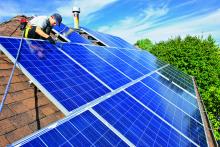By the Clean Energy Regulator

Image courtesy of iStock
Rooftop solar is one of the largest contributors in the reduction of carbon emissions from Australia’s electricity generation. Australia has the highest uptake of solar PV systems globally, with around 3.6 million in use. In the first half of 2023 an estimated 160,000 were installed.
The Clean Energy Regulator (CER) administers a number of Australian Government schemes to accelerate carbon abatement for Australia - by providing incentives for individuals, small businesses, and large corporations to reduce their greenhouse gas emissions and take up renewable sources of energy.
The Small-scale Renewable Energy Scheme (SRES), which includes rooftop solar, is undergoing reforms to effectively mature and develop alongside the burgeoning small-scale renewables industry.
A compliance issue the SRES has faced is making sure every installation is supervised by an accredited solar PV installer. We suspected that in some cases there was not even attendance by an accredited installer. Significant change was needed.
We introduced a requirement for installers to provide a written statement for each solar PV installation they install or supervise. The statement certifies they have met their obligations, including that they have physically attended the site. Installers must also maintain evidence of their attendance.

Image courtesy of Chris Oaten
Say cheese! Accredited installers now submit 3 photographs or selfies at the beginning, middle and end of an installation to prove their presence on site. This work was called the installer onsite verification program.
Using selfies with date and time stamps, geolocation and metadata is a novel regulatory approach for the CER. We identified that the selfies would be taken on the job which may include private residences and small businesses. The challenge was to create a process that was quick and easy to complete and managed both the privacy and compliance obligations.
Our work began with extensive communication to industry. We made sure we let them know how the requirements were changing and the reasons for change. We used website updates, webinars, emails and spoke directly with industry participants and we made it clear that those who did not comply with the changes would see action taken against them.
Many in the industry responded proactively to these communications. Several of the larger participants added ‘selfie’ functionality into their mobile apps. These are designed to capture the regulatory requirements for solar installations.
After several months of communication, we started requesting the selfies. We knew that many of these initial requests would not be able to be fulfilled and saw this as an opportunity to educate the scheme participants via formal correspondence. We clearly explained the new requirements and made it clear that further action would be taken if future requests were not met. Knowledge of these warnings spread rapidly through the industry.
Nudging compliance delivers
The communication campaign proved to be a significant ‘behavioural nudge’. Before we took any other action there was a 40% drop in the number of installers completing two or more installations per day. This supported our suspicion that some electricians may have been sharing registrations. Each installer should have their own registration.
Compliance success and new concerns
When we request installer selfies, we are seeing approximately 94% of requests being satisfied. However, we are now seeing new forms of non-compliance arise. Metadata on selfies along with some good (and not so good) photoshop attempts have been identified as growing concerns.
The CER is committed to our mission of accelerating carbon abatement for Australia and ensuring confidence in the schemes we regulate. Our Compliance priorities for 2023-2024 make clear our goal is for voluntary compliance. Because SRES is a mature industry, we are less tolerant to those who are unwilling to do the right thing. Stay tuned for future enforcement outcomes, both criminal and civil, against those who are intentionally non-compliant.




